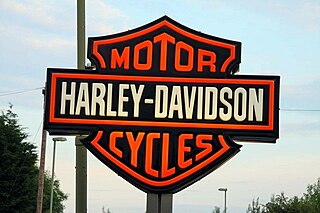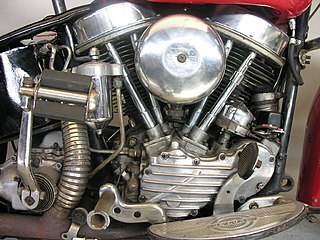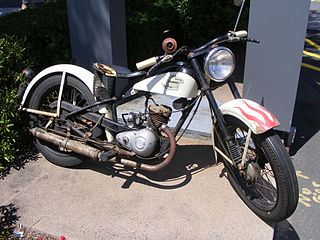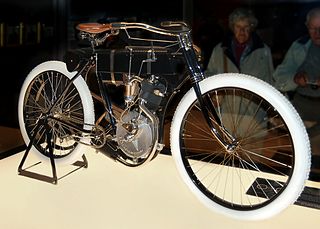
Harley-Davidson, Inc. is an American motorcycle manufacturer headquartered in Milwaukee, Wisconsin, United States. Founded in 1903, it is one of two major American motorcycle manufacturers to survive the Great Depression along with its historical rival, Indian Motorcycles. The company has survived numerous ownership arrangements, subsidiary arrangements, periods of poor economic health and product quality, and intense global competition to become one of the world's largest motorcycle manufacturers and an iconic brand widely known for its loyal following. There are owner clubs and events worldwide, as well as a company-sponsored, brand-focused museum.

The intake/inlet over exhaust, or "IOE" engine, known in the US as F-head, is a four-stroke internal combustion engine whose valvetrain comprises OHV inlet valves within the cylinder head and exhaust side-valves within the engine block.

Unit construction is the design of larger motorcycles where the engine and gearbox components share a single casing. This sometimes includes the design of automobile engines and was often loosely applied to motorcycles with rather different internal layouts such as the flat twin BMW models.

The Harley-Davidson WLA is a Harley-Davidson motorcycle that was produced to US Army specifications in the years during and around World War II. It was based on an existing civilian model, the WL, and is of the 45 solo type, so called due to its 45-cubic-inch (740 cm3) engine displacement and single-rider design. It acquired the nickname "Liberator".

Harley-Davidson FL is a model designation used for Harley-Davidson motorcycles since 1941, when F referred to the new large capacity 74 cui (1200cc) variant of the V-2 Overhead valve engine (″Knucklehead″) that was introduced in 1936 as Model E with 61 cui (1000cc). The presence of an additional letter L indicated higher compression, offering more power but requiring higher octane gasoline. In 1950s, the low compression version was discontinued, and in 1952 also the low capacity EL, making FL the standard engine and model designation for decades to come.

The Harley-Davidson XA was a flat-twin, shaft drive motorcycle made by Harley-Davidson for the US Army during World War II.

The Harley-Davidson Servi-Car is a three-wheeled utility motorcycle that was manufactured by Harley-Davidson from 1932 to 1973.

A motorcycle frame is a motorcycle's core structure. It supports the engine, provides a location for the steering and rear suspension, and supports the rider and any passenger or luggage. Also attached to the frame are the fuel tank and battery. At the front of the frame is found the steering head tube that holds the pivoting front fork, while at the rear there is a pivot point for the swingarm suspension motion. Some motorcycles include the engine as a load-bearing stressed member; while some other bikes do not use a single frame, but instead have a front and a rear subframe attached to the engine.

The Hummer was a motorcycle model manufactured by Harley-Davidson from 1955 to 1959. However, the name "Hummer" is now incorrectly used generically to refer to all American-made single-cylinder two-stroke Harley-Davidson motorcycles manufactured from 1948 to 1966. These motorcycles were based on the DKW RT125, the drawings for which were taken from Germany as war reparations after World War II. The RT125 drawings were also given to the United Kingdom and the Soviet Union as war reparations, resulting in the BSA Bantam and the MMZ M-1A Moskva, later known as the Minsk.

Rikuo Internal Combustion Company was one of the first motorcycle manufacturing companies in Japan. In the early 1930s Rikuo operated under the license and name of Harley-Davidson, using their tooling, and later under the name Rikuo until 1958. Harley-Davidson themselves did not publicize this Japanese connection because the Japanese were helped in developing mass-production techniques by the introduction of this factory into Japan just prior to the Second World War. The Society of Automotive Engineers of Japan(in Japanese) rates the 1935 Rikuoh Large Motorcycle as one of their 240 Landmarks of Japanese Automotive Technology.

The Type 97 motorcycle, or Rikuo, was a copy of a Harley-Davidson motorcycle produced with a sidecar from 1935 in Japan under license from Harley-Davidson by the Sankyo Company. Some 18,000 of the machines were used by the Imperial Japanese forces during World War II. A variation was also manufactured without a side car, called the Type 93.

The Harley-Davidson XR-750 is a racing motorcycle made by Harley-Davidson since 1970, primarily for dirt track racing, but also for road racing in the XRTT variant. The XR-750 was designed in response to a 1969 change in AMA Grand National Championship rules that leveled the playing field for makes other than Harley-Davidson, allowing Japanese and British motorcycles to outperform the previously dominant Harley-Davidson KR race bike. The XR-750 went on to win the most races in the history of American Motorcyclist Association (AMA) racing.

The Cleveland Motorcycle Manufacturing Company, sometimes called Cleveland Motorcycle, was a motorcycle manufacturer in Cleveland, Ohio, from 1902 to 1905 and again from 1915 to 1929.

The Harley-Davidson Model W, also known as the Sport Twin, is a motorcycle made by Harley-Davidson from 1919 to 1923. Unusually for a Harley-Davidson motorcycle, the Model W had a flat-twin engine and a trailing link fork. The Model W set speed records on runs from New York City to Chicago and from the Canada–United States border to the Mexico–United States border. Slow home market sales led to the end of production after four years.
A stressed member engine is a vehicle engine used as an active structural element of the chassis to transmit forces and torques, rather than being passively contained by the chassis with anti-vibration mounts. Automotive engineers use the method for weight reduction and mass centralization in vehicles. Applications are found in several vehicles where mass reduction is critical for performance reasons, usually after several iterations of conventional frame/chassis designs have been employed.

The Harley-Davidson KR or KR750 was a 45.125 cu in (739.47 cc) displacement V-twin engine racing motorcycle made by Harley-Davidson from 1953 through 1969 for flat track racing. It was also used in road racing in the KRTT faired version. When the KR was first introduced, it dominated motorcycle racing in the United States. In 1970 it was replaced by the long-lived and US race-winning Harley-Davidson XR-750.

Flathead motorcycles are a type of bike that was a standard for pre-war motorcycles, in particular US V-twins such as Harley-Davidson and Indian, some British singles, BMW flat twins and Russian copies thereof.

The Harley-Davidson Model 1 was the first motorcycle produced by the American manufacturer Harley-Davidson. The purchase price was 200 US dollars; 38 copies were made.



















